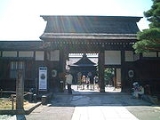
Jin'ya
Encyclopedia

Edo period
The , or , is a division of Japanese history which was ruled by the shoguns of the Tokugawa family, running from 1603 to 1868. The political entity of this period was the Tokugawa shogunate....
of Japanese history
History of Japan
The history of Japan encompasses the history of the islands of Japan and the Japanese people, spanning the ancient history of the region to the modern history of Japan as a nation state. Following the last ice age, around 12,000 BC, the rich ecosystem of the Japanese Archipelago fostered human...
, a was the administrative headquarters of a small domain or parcel of land held by the Tokugawa shogunate
Tokugawa shogunate
The Tokugawa shogunate, also known as the and the , was a feudal regime of Japan established by Tokugawa Ieyasu and ruled by the shoguns of the Tokugawa family. This period is known as the Edo period and gets its name from the capital city, Edo, which is now called Tokyo, after the name was...
, as well as the residence of the head of the administration, and the associated grain storehouse. While larger domains had castles, certain smaller domains did not, and the jin'ya, much smaller than a castle, housed the administration. Some, such as the Komono Jin'ya in Komono
Komono, Mie
is a town located in Mie District, Mie, Japan.As of 2010, the town has an estimated population of 40,133 and a density of 375 persons per km². The total area is 106.89 km².-Education:...
, Mie Prefecture
Mie Prefecture
is a prefecture of Japan which is part of the Kansai regions on Honshū island. The capital is the city of Tsu.- History :Until the Meiji Restoration, Mie prefecture was known as Ise Province and Iga Province....
, had a watchtower (yagura), mimicking the donjon of a castle. Others had moats or earthen walls, in some cases left over from an earlier castle on the site.
Generally, domains assessed at 30,000 koku
Koku
The is a Japanese unit of volume, equal to ten cubic shaku. In this definition, 3.5937 koku equal one cubic metre, i.e. 1 koku is approximately 278.3 litres. The koku was originally defined as a quantity of rice, historically defined as enough rice to feed one person for one year...
or less had a jin'ya instead of a castle. Additionally, they were found on shogunal lands and those headed by hatamoto
Hatamoto
A was a samurai in the direct service of the Tokugawa shogunate of feudal Japan. While all three of the shogunates in Japanese history had official retainers, in the two preceding ones, they were referred to as gokenin. However, in the Edo period, hatamoto were the upper vassals of the Tokugawa...
, and within large domains jin'ya served as district headquarters (gun daikan-sho). They were also found in exclaves of domains.
The "three great jin'ya" were at the Iino
Iino Domain
was a Japanese domain of the Edo period, located in Kazusa Province , Japan. It was centered on Iino Jin’ya, a fortified residence in what is now the town of Futtsu, Chiba...
, Tokuyama
Tokuyama Domain
The ' was a Japanese domain of the Edo period, located in Suo Province . It was a branch of the neighboring Chōshū Domain.-List of lords:*Mōri clan #Naritaka#Motokata#Mototsugu#Mototaka...
and Tsuruga Domains.
Source
- This article incorporates material from 陣屋 (Jin'ya) in the Japanese Wikipedia, retrieved on February 24, 2008.

